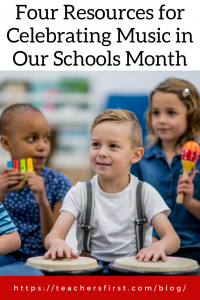Each March, schools celebrate Music in Our Schools Month. What began as a statewide celebration in New York in 1973 is now a month-long focus for schools around the country. This event aims to raise awareness of and support for music education for all students.
It’s not difficult to find information supporting the vital role of music within schools. This article from DoSomething.org (reviewed here) shares eleven crucial facts to consider, many of which point toward increased academic success for students who participate in music programs.
Unfortunately, many students don’t have access to quality music education programs. Financial considerations are the most obvious reason, but other factors include lack of qualified teachers, elimination of music programs in favor of academic offerings, or the impact of coronavirus. As schools turned to remote learning, music classes were among those that suffered, and it became challenging to offer vital hands-on instruction.
Even at an early age, students can recognize their interest and aptitude for music. However, students who don’t see themselves as musicians may not fully participate in music activities even when they are offered. Luckily, several engaging websites provide users—even for those who don’t consider themselves to be musically inclined—the opportunity to explore music in a variety of ways.
Consider sharing any or all of the following sites with students as an opportunity to explore the musical side they haven’t yet discovered. Include these sites as part of a computer center activity, as a homework alternative, or as part of your ongoing celebration of Music in Our Schools Month.
- Blob Opera (reviewed here) – This activity comes from Google Arts and Culture. Users drag four adorable blobs around the screen to experiment and create music with the four voices. Follow the instructions to drag blobs up and down to change pitch or forward and backward to change vowel sounds. The blobs even have a tour! Click the globe icon to watch the blobs sing songs inspired by cities worldwide. As students interact with Blob Opera, they learn about music composition, voice types, and music arrangement through experimentation. Blob Opera even includes a handy record button you can use to record and share students’ creations.
- Rhythm Trainer (reviewed here) – This handy tool helps students explore rhythm through various activities. It includes a “gentle start” where a series of exercises helps users learn to recognize different beats and musical notations. The training lessons provide several other methods of learning rhythms. The virtual instruments, rhythm dice, and a random rhythm generator are additional areas to explore.
- Groove Pizza (reviewed here) – This activity is all about drums! This introductory video helps introduce the concept and features of Groove Pizza, which uses geometric visualizations to accompany rhythms. The rhythm is represented on a grid and within a circle at concurrent times. Build your own creations, use the special link to view pre-made grooves, or drag shapes onto the circle to play prerecorded beats. Finally, share your work by copying and pasting a link, sharing to social media, or downloading as a MIDI file.
- Boomy (reviewed here) – This application uses artificial intelligence to create music. You’ll need an account, so consider creating one to use as a class. Begin by selecting a music style, then refine your choice using the options provided. After making selections, be patient while Boomy creates your song—it may take a minute or so. This is when the fun begins! Use the provided editing to add vocals, adjust the arrangement, or change settings in the composition. If the recording isn’t to your liking, reject the design and start over! Copy the link to your compositions to share with others.
Introducing music through experimentation and hands-on activities is an excellent way to engage and interest students in music. During Music in Our School Month, take time to provide your students with tools to explore music concepts in creative ways. Who knows? One of your students might be the next great composer or songwriter!
Do you have a favorite music activity or resource? As always, we enjoy hearing your ideas and tips for other educators in the comments!


